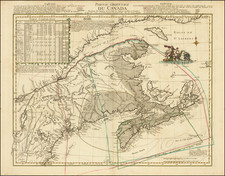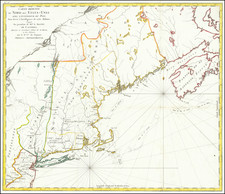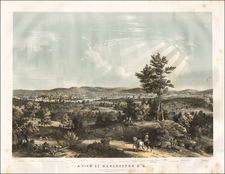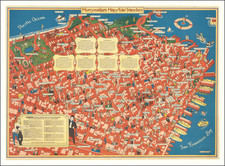Scarce pictorial map of Connecticut, published by the Connecticut Society of the Colonial Dames of America.
The following description appears on the Connecticut Historical Society museum website, describing the original artwork for this map:
Gallery Copy : In 1930, Mary Pierson Cheney, president of the Colonial Dames, asked Mathias Spiess, a tobacco broker and the unofficial historian of the town of Manchester, to compile a map based on his extensive research on the Indians of Connecticut. The map itself was drawn by Hayden L. Griswold, a prominent Manchester civil engineer, and incorporates decorative details from early Dutch maps of New England. The Connecticut Society of Colonial Dames of America distributed more than 2000 copies of this map to libraries and historical societies throughout the state.
Description : Manuscript map of Connecticut circa 1625, divided into Native American sachemdoms and showing trails and villages. The tribes whose names appear on the map are the Siwanogs, Paugussetts, Quinnipiacs, Tunxis, Massacoes, Agawams, Sicaogs, Poquonocks, Podunks, Wangunks, Menunkatucks, Hammonassetts, Nipmucks, Mohegans, Uncas, Nehantics and Pequots. Elevation is conveyed through drawings of groups of hills. A bear, beaver, turkey, deer, fox and what appears to be an otter are depicted on the map. Around it are a baby on a cradleboard, fenced-in clusters of wigwams, a bow and two arrows, a pipe decorated with feathers, and a decorated shield and spear. Tribal names also appear outside of the borders of Connecticut, and probably refer to the tribes that lived in what is now New York, Massachusetts and Rhode Island: Mohicans, Agawams, Nipmucks and Nehantics. Native Americans in three dugout canoes appear below the landmass, in what is unlabeled Long Island Sound. The cartouche depicts the title on a stretched skin, with two Native Americans on either side, dressed in loinclothes and wearing feathers in their hair. The one on the right is standing and holds a bow. In the lower left corner is a legend that explains the lines and symbols representing main and secondary trails, villages and sachemdom boundaries.










![Partie De L'Amerique Septent? Qui comprend La Nouvelle France ou Le Canada . . . [Large Great Lakes Inset]](https://storage.googleapis.com/raremaps/img/small/48752.jpg)


![[Placerville, California]](https://storage.googleapis.com/raremaps/img/small/63008.jpg)
